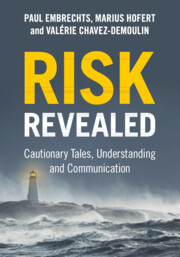Book contents
- Frontmatter
- Dedication
- Contents
- Preface
- Introduction
- 1 The 1953 Great Flood
- 2 The Space Shuttle Challenger Disaster
- 3 The 2007–2008 Financial Crisis
- 4 Earthquakes and Tsunamis
- 5 The L’Aquila Trial and the Public Communication of Risk
- 6 The Coronavirus Pandemic
- 7 Mathematical Wonderland
- 8 Stochastic Modeling
- 9 The Modeling of Extreme Events
- 10 On Climate Change and Related Risk
- 11 Further Examples from the World of Extremes
- 12 Networks
- 13 The Black Tulip and February 3, 1637
- A Note About the References
- References
- Index
8 - Stochastic Modeling
Published online by Cambridge University Press: 05 April 2024
- Frontmatter
- Dedication
- Contents
- Preface
- Introduction
- 1 The 1953 Great Flood
- 2 The Space Shuttle Challenger Disaster
- 3 The 2007–2008 Financial Crisis
- 4 Earthquakes and Tsunamis
- 5 The L’Aquila Trial and the Public Communication of Risk
- 6 The Coronavirus Pandemic
- 7 Mathematical Wonderland
- 8 Stochastic Modeling
- 9 The Modeling of Extreme Events
- 10 On Climate Change and Related Risk
- 11 Further Examples from the World of Extremes
- 12 Networks
- 13 The Black Tulip and February 3, 1637
- A Note About the References
- References
- Index
Summary
This rather long chapter constitutes part of the hike in our walk/hike/stroll set-up. We introduce the reader to the basics of stochastics (representing both probability and statistics) necessary for the more technical discussions on risk later. The path followed starts from probability space (a theoretical concept we quickly leave aside); we then move to the notion of a random variable and,, its distribution function, including the most important discrete as well as continuous examples. Historical examples as well as pedagogical ones are always included in order to support the understanding of the new concepts introduced. These examples often show that there is more to randomness than meets the eye. For the applications discussed later, we will measure statistical uncertainty through the concept of confidence intervals. These can be based either on some asymptotic theory involving the famous bell curve, the normal distribution, or on some form of resampling known under the name of bootstrapping. Further, we add some tools that are very important for measuring and communicating risk; these include the concepts of return periods and quantile functions.
Keywords
- Type
- Chapter
- Information
- Risk RevealedCautionary Tales, Understanding and Communication, pp. 94 - 218Publisher: Cambridge University PressPrint publication year: 2024

